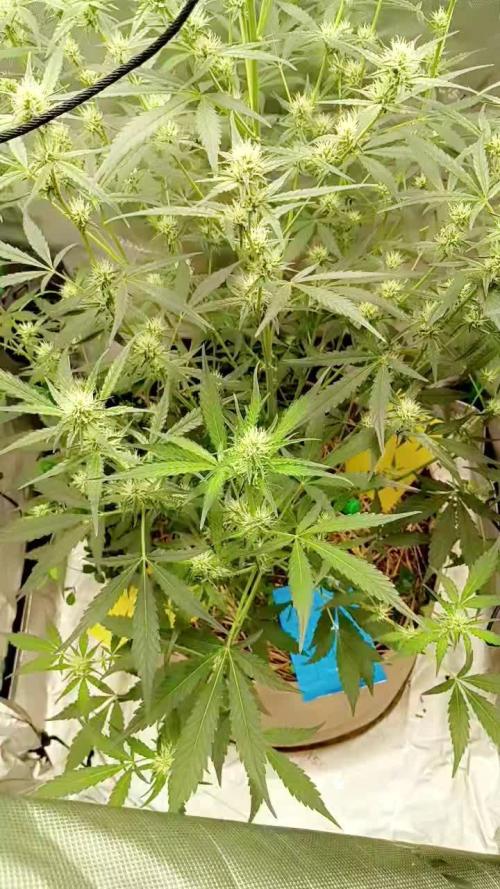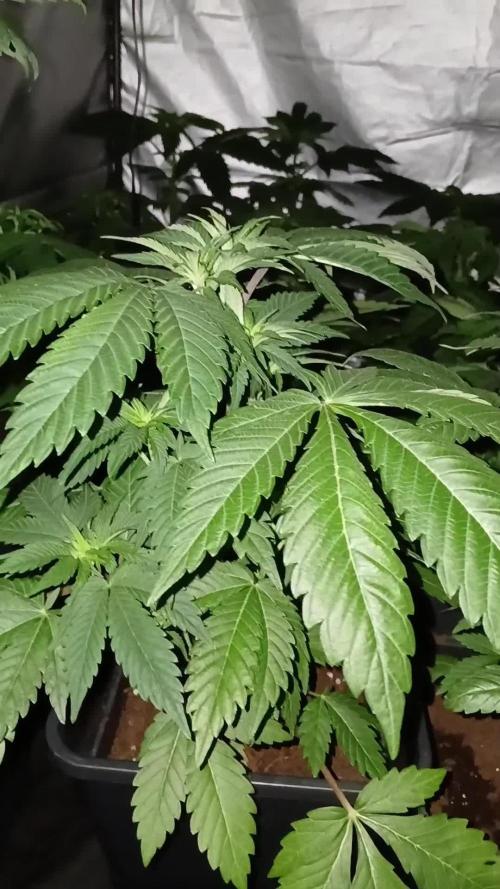The Grow Awards 2026 🏆 



























Likes
5
Share


@eldruida_lamota
Follow
Que pasa familia, vamos con la sexta semana de floración de estas GG4 Sherbet Fast Flowering, de FastBuds.
Agradezco a Agrobeta todos los kits obtenidos de ellos 🙏.
Ya veis que llevan buen ritmo ya tiene un color espectacular.
Vamos al lío, El ph se controla en 6.2 , la temperatura la tenemos entre 21/24 grados y la humedad ronda el 50%, 7 litros de sustrato. Iremos viendo cómo avanzan.
Agrobeta:
https://www.agrobeta.com/agrobetatiendaonline/36-abonos-canamo
Hasta aquí todo, Buenos humos 💨💨💨
Likes
17
Share


@TAXFR33
Follow
Now that the majority of the hard work is i can get some good pics and videos next week when i’m down
Likes
4
Share


@CWolcott1991
Follow
11/12 start of week 3 of flower hoping she is done stretching cus I'm out of room when it comes to height. Gave all the goodies plus added Fulpower and molasses
11/15 stretching seems to have stopped. Dropped humidity and raised vpd to stay around 1.5 super cropped the main top to be more level with all the side branches that are pretty uniform and cranked ppfd to the tallest top to 1000 ppfd
Likes
9
Share


@Siriuz
Follow
Alright guys, now we're up to date
I didn't write that much before because I wanted to get here first.
Actual date
Feb 10th
They're looking good
No nutrient burnt so far
24/0 Schedule
Watering every 2 days but continue to spray on them like 2 liters everyday to increase humidity lvl to optimal condition
Temp is OK
Wish it was better but have to repair A/C
Anyways bout the girl
This gorilla girl XL is slow but developing good, taking her time to grow while it's fully LST, she's redirecting her energy to the other stems and leaves plus main trunk and slowly continues to grow its main stem
We're already on 1900PPM
We've been giving nutes from the very beginning plus bloom to make sure she gets loaded, but certainly lil bit not to mess up too much with her so we already on 1300ppm bloom stuff 😏
Want to get big yield let's see if we as much as we want
Likes
16
Share


@GrowerGaz
Follow
Just water as they are very small , light is a 100w Samsung led light for the first week then I will switch to the Zeus 465w Compact pro.
I have repotted the plants now the seeds have popped, they are in 2 litre pots now. As soon as the toots hot the bottom of the pots I will put them in my autopots system.
I have tried adding a layer of perlite on top of the bAc soil. To try and stop any bugs getting into my soil and also reflect the light back.
Likes
28
Share


@GodZilla_Owner
Follow
Not much to report this week, the trichomes are still milky. My feeling is that it will take another 2-3 weeks until they are ready to harvest.
Until then, I will continue with the fertilizer scheme. The smell of both strains is very pleasantly fruity (citrus) and I continue to monitor the VPD value and temperatures.
This time there are no pictures and only videos they show better the development, in the time lapse you can still see a growth in the flowers, slow but there is still growth.
Likes
18
Share


@Grower_Of_Persia
Follow
week intel:
its time to harvest some of plants the ones that is mature enough. indica dominant plants will done first always so we should harvest them first
because my base nutrients and one of boosters was salt based, i'll do flushing this week to get some relieve to plants in the last days
stresses :
flushing
Drought stress via watering only one time with flushing this week
feeding:
day 1 : i flushed them with Advanced Nutrients Flawless finish and adjusted ph
day 3 : no more feeding from now on
day 5 : no more feeding from now on
guide of the week :
i harvest in 2 parts : first i harvest top of the branches and will let the lower buds to ripe another week then ill harvest the second wave.
indica dominant plants will get done 1 or 2 weeks sooner than sativa dominant plants that will often takes more than 8 weeks so be aware to harvest them sooner.
my dry and cure style is this:
3 days of hanging upside down to get water activity lower to around 0.6 in 50% humidity and 26 C temp (i know its a little high but we are in a hot summer right now and i cant get it lower even with air conditioner) and then after 3 days of drying i remove leaves and stalks, trim buds and move them to jar for the rest of their life :D . and in the first 4 days of curing i open the jar door and let hem get some fresh air in the jar for about 5 minutes and close the jar door again, after 4 days of curing like that buds are smokable but they will get better as they getting cured about 1 month.
im happy as hell with this harvest :D.
Likes
13
Share


@Mastr
Follow
This week they preflowering and this strain very fast flowering just bit short and she won't strech much in preflowering
Day 49 end week 7 both plant very bushy and healthy
Likes
36
Share


@grundoh
Follow
Right now I am just playing the waiting game with White Widow and Industrial Plant. Both have shown signs of maturation with their trichomes but neither one has a majority of milky trichomes yet. In hindsight, I should have waited until Industrial Plant was more mature before I started flushing her -- I've lost a few weeks that I could have been continuing to fatten her up. I added more bamboo rods and tied branches to them with some plant tape on both plants. White Widow's buds are rock hard and keep bending its branches so hopefully the extra support will help.
I cut off the main cola and a side cola of Industrial Plant CBD due to bud rot that I failed to notice for roughly a week. After cutting out all of the bud rot I could find on Industrial Plant I checked over her and White Widow meticulously to make sure everything was kosher. I added a spare oscillating fan in the tent to try and improve air circulation in the room. I have had trouble with humidity and temperature shifts throughout this grow -- something I'll have to dial in as I progress. I imagine the climate shifts combined with how thick the main cola was probably contributed to the bud rot.
Seedsman White Widow Auto is ready to be harvested as of Day 100. Over 2 days her trichomes really started to turn amber. I have started flushing her as of today and plan to harvest a day or two into the start of Week 15. As for Dinafem Industrial Plant Autoflowering CBD? I am thinking of just cutting my losses if her trichomes haven't gotten to at least majority-milky by the time White Widow gets chopped. She just looks mostly-dead and only wants a drink once every 7-10 days now. That and I have some new gear I really want to test out, as well as some different ideas for my second run that I've been itching to get started on.
Likes
2
Share


@La_VecinaCannabica
Follow
Las plantas y sus tallos y ramas son mas fuertes,piden mas riego por lo tanto podré fertilizar algo más, siempre alternando con agua sola y con la EC óptima y el PH veremos esas porras salir🤜🏻🤛🏻💚
Likes
12
Share


@Kayanesta
Follow
Smells amazing, buds are greesy to the touch…serious genetics from fast buds!
Likes
6
Share


@Sirdukevonwalter
Follow
Day 46, plants are slowing down. They'll be one more push, but this will not be like the last week and a half so itsbtime to slow things down.
I see some signs that i need to reduce the nutrients. Signs being slight tip burn on a very few the fans with a hook upwards indicating transpiration doesn't balance with light intensity, more noticeable and trustworthy signs are the darker shiney/waxy leaves inside the canopy. I'm not sure if my video uploaded or its quality while I write this, so I will comment on that later.
Being only 3 weeks until harvest I've also cut the CO2. If looking close, the upper buds are starting to throw new pistils and elongate indicating that the co2 and heat may cause foxtailing if I push any further.
I've reduced co2 from 850 to 650 and light from 1000ppfd, to 850ppfd and then this morning to 700ppfd. End of next week I will reduce even further to around 550ppfd before the last week at 400ppfd during the flush. All this lowers the temperature and slows transpiration.
I've reduced the EC from 2 to 1.7EC and turned on my mister as well to maintain humidity to 55% . One less variable to worry about..humidity was fluctuating 47-53% last week. Higher humidity also slowing transpiration of water and nutrients. Hoping these changes have set the girls up to only get just the right amount to finish pretty..
Next week, tomorrow the nutrient mix will have full tilt instead of the bulkyB.
Likes
7
Share


@BIYEI
Follow
Lavado de raiz (Tiempo estimado 10 - 14 dias)
Segunda semana de lavado.
25/03/2024 - 5:00hrs y 22hrs: Se hace cambio de agua y se calibra el ph, Sin nutrientes, Se hace Lavado de cubetas, tuberias, bomba, humificador, y perifericos, Se realiza limpieza completa del indoor, Se verifican parámetros básicos del agua, mantener cuidados específicos.
Agua de osmosis: Ph 6.0, PPm ---, Ec 0.5, Temperatura 18°C - 24°C
Ambiente: Temperatura 19-25 °C, Humedad 55%, Ventilación 20%, 12 hrs de luz , 12 hrs de obscuridad.
26/03/2024 - 5:00hrs y 22hrs: Se verifican parámetros básicos del agua, mantener cuidados específicos.
Agua de osmosis: Ph 6.0, PPm ---, Ec 0.5, Temperatura 18°C - 24°C
Ambiente: Temperatura 19-25 °C, Humedad 55%, Ventilación 20%, 12 hrs de luz , 12 hrs de obscuridad.
27/03/2024 - 5:00hrs y 22hrs: Se verifican parámetros básicos del agua, mantener cuidados específicos.
Agua de osmosis: Ph 6.0, PPm ---, Ec 0.5, Temperatura 18°C - 24°C
Ambiente: Temperatura 19-25 °C, Humedad 55%, Ventilación 20%, 12 hrs de luz , 12 hrs de obscuridad.
28/03/2024 - 5:00hrs y 22hrs: Se verifican parámetros básicos del agua, mantener cuidados específicos.
Agua de osmosis: Ph 6.0, PPm ---, Ec 0.5, Temperatura 18°C - 24°C
Ambiente: Temperatura 19-25 °C, Humedad 55%, Ventilación 20%, 12 hrs de luz , 12 hrs de obscuridad.
29/03/2024 - 5:00hrs y 22hrs: Se verifican parámetros básicos del agua, mantener cuidados específicos.
Agua de osmosis: Ph 6.0, PPm ---, Ec 0.5, Temperatura 18°C - 24°C
Ambiente: Temperatura 19-25 °C, Humedad 55%, Ventilación 20%, 12 hrs de luz , 12 hrs de obscuridad.
30/03/2024 - 5:00hrs y 22hrs: Se verifican parámetros básicos del agua, mantener cuidados específicos.
Agua de osmosis: Ph 6.0, PPm ---, Ec 0.5, Temperatura 18°C - 24°C
Ambiente: Temperatura 19-25 °C, Humedad 55%, Ventilación 20%, 12 hrs de luz , 12 hrs de obscuridad.
31/03/2024 - 5:00hrs y 22hrs: Se verifican parámetros básicos del agua, mantener cuidados específicos.
Agua de osmosis: Ph 6.0, PPm ---, Ec 0.5, Temperatura 18°C - 24°C
Ambiente: Temperatura 19-25 °C, Humedad 55%, Ventilación 20%, 12 hrs de luz , 12 hrs de obscuridad.
Likes
10
Share


@HideAndFly420
Follow
.
Day 20, started some lst on the baby great response from this plant
Day 21 everything is going good, maybe a little slower but I think it will retake is time I just adjusted lamp and ph. Let’s see




























